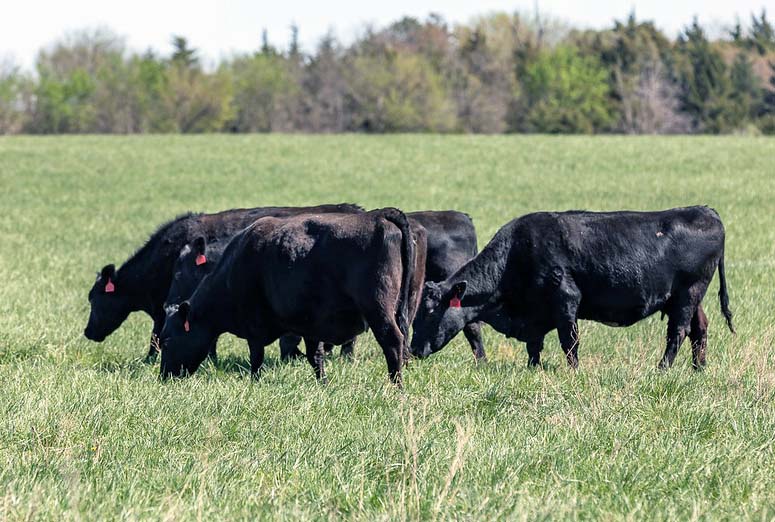
K-State beef cattle experts say it is important to monitor the herd as animals transition to a grass diet in the spring. | Download this photo.
Cattle Chat: Transitioning to grass
K-State beef cattle experts offer strategies to follow when moving animals from hay to grass diets
April 5, 2022
By Lisa Moser, K-State Research and Extension news service
MANHATTAN, Kan. — Anyone who has ever eaten too many prunes, can attest that over consumption can sometimes have a negative impact on one’s digestive tract.
Just as with humans, what cattle eat can also trigger a reaction in their digestive systems, according to the experts at the Kansas State University Beef Cattle Institute.
Talking on a recent Cattle Chat podcast, veterinarians Bob Larson, Brad White and Brian Lubbers and nutritionist Phillip Lancaster said the transition of cattle from eating winter hay to grazing lush, green pastures can cause the cattle to experience a change in their stools.
“Cattle are now grazing grass that is 85-90% moisture, 15-20% protein and low in fiber. Those three things combined lead to a faster passage rate through the digestive tract, making the manure loose,” Lancaster said.
While this type of stool appears to be diarrhea, the veterinarians say it doesn’t present a health concern.
“This is not a disease condition. Rather it is just the result of all the water passing through the tract quickly,” White said.
When given the option of green grass or hay to eat, the veterinarians agree that green grass will be what cattle prefer to consume. So, one option to help manage the loose stools involves a change in the way the cattle are managed, according to Larson.
“A more labor-intensive strategy is to pull the cattle off the grass at night and lock them in a pen where hay is the only option and that may force them to change the composition of their diet,” he said.
Monitoring for grass tetany during turnout
One health condition that can afflict cattle when they first go out to pasture in the weeks following calving is called grass tetany.
“If cattle consume a grass that is low in magnesium and high in potassium, it can lead to nervous system problems,” Larson said. He added that cattle experiencing grass tetany may act aggressive and have muscle twitches. Cattle may not be able to get up, and if the condition progresses without treatment, the cattle will die.
Larson and Lubbers stressed that if any of those symptoms appear, producers need to involve a veterinarian quickly.
“Treatment is intravenous fluid that can restore the minerals,” Larson said.
Lubbers added: “With IV treatment, the cattle tend to respond quickly and are acting normally again within 15-20 minutes but should continue to be monitored to be make sure the disease does not reoccur.”
There are a few management strategies to follow to reduce the risk of grass tetany, said the experts.
“One strategy is to feed a high-magnesium mineral supplement a few weeks prior to pasture turnout,” White said.
Lancaster said that the type of grass they are grazing will present varying levels of risk.
“The risk for this condition is not as high on the native, warm season grasses of the Flint Hills as compared to cool season grasses that have been fertilized,” Lancaster said, adding that the nitrogen in the fertilizer will lead to an increase in potassium in the grass.
Where it makes sense, Lancaster said producers can plant some legumes in the cool season grass pastures to offer a better mineral balance for grazing cattle.
To hear more of this discussion, listen to the Cattle Chat podcast online.

